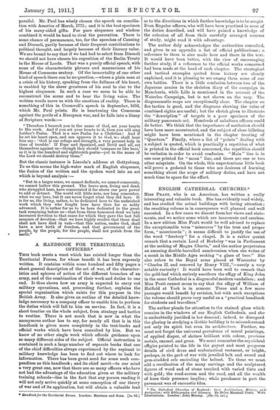ENGLISH CATHEDRAL CHURCHES.* Miss PRATT, who is an American, has
written a really interesting and valuable book. She has evidently read widely, and has studied the actual buildings with loving attention ; the resulting volume is in consequence well planned and well executed. In a few cases we dissent from her views and state- ments, and we notice some which are inaccurate and careless-. In a new edition Miss Pratt would be well advised to replace the exceptionable term " misereres " by the true and proper form, " misericords "; it seems difficult to justify the use of the word " feretory " for a chapel. It is a rather quaint remark that a, certain Lord of Berkeley "was in Parliament at the making of Magna Charta," and the author perpetrates an amusing double-barrelled anachronism when she writes of a monk in the Middle Ages seeking " a glass of beer." She also refers to the Royal arms placed at Worcester by "Charles II. and renewed by Henry VIII.,"—surely a very. notable curiosity ! It would have been well to remark thab the gold-leaf which entirely smothers the effigy of King John in the same Cathedral is a disgraceful modern vandalism ; and Miss Pratt cannot mean to say that the effigy of William of Hatfield at York is in armour. These and a few more passages would benefit by revision, but with such exceptions. the volume should prove very useful as a "practical handbook for students and travellers."
The author pleads for attention to the stained glass which. remains in the windows of our English Cathedrals, and she is undoubtedly justified in her demand ; indeed, to disregard, the glazing in studying a Gothic building is to misunderstand. not only its spirit but even its architecture. Further, we must not forget the universal prevalence of mural paintings, of applied diaper, of shrines brilliant with colour, precious metals, enamel, and gems. We must remember the sepulchral effigies painted to the life in the gayest and most gorgeous details of civil dress and ecclesiastical vestment, or bright,. perhaps, in the garb of war with jewelled belt and sword and gem-studded orle encircling the helmet. To these we must add a recollection of the many carvings and the sculptured. figures of wood and of stone touched with varied tints and with gold ; the rood-screen and the rood, and all the wealth of- hues their presence implies ; while perchance in part the pavement was of encaustic tiles.
• The Cathedral Churches of England : their Architecture, History, and? Antiquities; with Bibliography and Glossary. By Helen MarshallPratt. With Illustrations. London: John Murray. [10s. 6& net.]










































 Previous page
Previous page